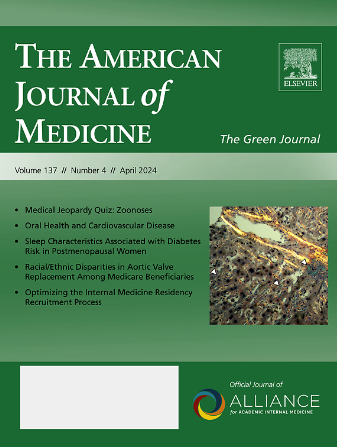初级医疗实践中急性肾损伤实验室证据的发生率、识别和随访:对 93,259 项肌酐检测结果的分析。
IF 2.5
3区 医学
Q1 MEDICINE, GENERAL & INTERNAL
引用次数: 0
摘要
背景:社区获得性急性肾损伤(CA社区获得性急性肾损伤(CA-acute kidney injury)在门诊环境中未得到充分认识,且与不良后果相关:我们分析了社区获得性急性肾损伤在学术性初级保健实践和社区健康中心的发病率,并评估了通过重复肌酐测量(闭环)确定的识别/随访情况。我们审查了自 2018 年 1 月 1 日至 2021 年 12 月 31 日期间 36,593 名患者的 93,259 份标本:结果:共有 220 名患者患有 CA 急性肾损伤,其定义为肌酐较基线升高 >75%;发病率为 150/100,000 (0.5%):发病率:150/100,000(每年 0.15%)。137名患者(62.3%)在30天内复查了血清肌酐。对 83 名(37.72%)开环患者的病历进行复查后发现,69/83(83.1%)名患者没有复查血肌酐。襻闭合组(0.92±0.4mg/dl; 84.45±27.49mls/min)与襻开放组(0.63±0.34mg/dl; 105.19±26.67mls/min)相比,襻闭合组的平均基线肌酐更高,eGFR更低(P结论:临床医生经常忽视 eGFR 的临床显著变化,尤其是当基线肌酐和事件肌酐水平处于 "正常 "范围时。本文章由计算机程序翻译,如有差异,请以英文原文为准。
Incidence, Recognition, and Follow-up of Laboratory Evidence of Acute Kidney Injury in Primary Care Practices: Analysis of 93,259 Creatinine Results
Background
Community-acquired acute kidney injury (CA-acute kidney injury) is under-recognized in the outpatient setting and is associated with adverse outcomes.
Methods
We analyzed the incidence of CA-acute kidney injury in an academic primary care practice and community health center and assessed recognition and follow-up as determined by repeat creatinine measurement (closed-loop). We reviewed 93,259 specimens for 36,593 unique patients from January 1, 2018, through December 31, 2021.
Results
There were 220 unique patients with CA-acute kidney injury, defined as a > 75% increase in creatinine from baseline (incidence: 150/100,000; 0.15% per year). One hundred thirty seven patients (62.3%) had repeat serum creatinine performed within 30 days. Chart reviews of the 83 (37.72%) patients with open loops found there was no follow-up creatinine ordered in 69/83 (83.1%) patients. Mean baseline creatinine was higher and estimated glomerular filtration rate (eGFR) was lower in the closed-loop group (0.92 ± 0.4 mg/dL; 84.45 ± 27.49 mL/min) vs the open-loop group (0.63 ± 0.34 mg/dL; 105.19 ± 26.67 mL/min) (P < .0001). Preexisting chronic kidney disease was more prevalent in closed-loop patients (35/137; 25.6%) compared with those with open loops (3/83; 3.6%). Patients with baseline chronic kidney disease were more likely to have closed loops. Progression to new chronic kidney disease was common among CA-acute kidney injury patients, occurring in 25% of open-loop and 24.1% of closed-loop patients. New baseline eGFR was lower in all groups.
Conclusions
Clinicians frequently overlooked a clinically significant change in eGFR, especially when the baseline creatinine and incident creatinine levels were in the “normal” range.
求助全文
通过发布文献求助,成功后即可免费获取论文全文。
去求助
来源期刊

American Journal of Medicine
医学-医学:内科
CiteScore
6.30
自引率
3.40%
发文量
449
审稿时长
9 days
期刊介绍:
The American Journal of Medicine - "The Green Journal" - publishes original clinical research of interest to physicians in internal medicine, both in academia and community-based practice. AJM is the official journal of the Alliance for Academic Internal Medicine, a prestigious group comprising internal medicine department chairs at more than 125 medical schools across the U.S. Each issue carries useful reviews as well as seminal articles of immediate interest to the practicing physician, including peer-reviewed, original scientific studies that have direct clinical significance and position papers on health care issues, medical education, and public policy.
 求助内容:
求助内容: 应助结果提醒方式:
应助结果提醒方式:


